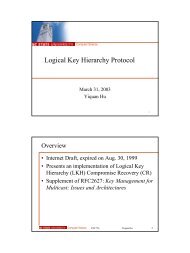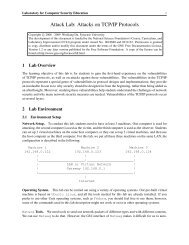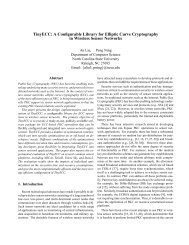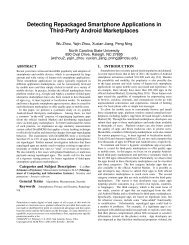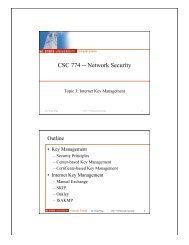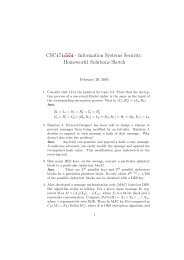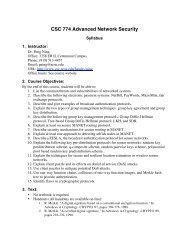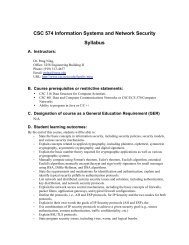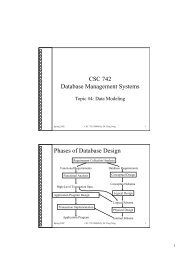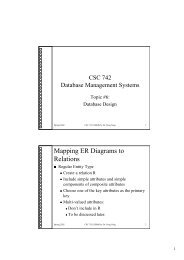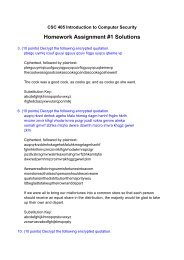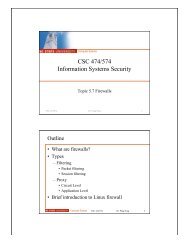A Flexible Approach to Intrusion Alert Anonymization and Correlation
A Flexible Approach to Intrusion Alert Anonymization and Correlation
A Flexible Approach to Intrusion Alert Anonymization and Correlation
Create successful ePaper yourself
Turn your PDF publications into a flip-book with our unique Google optimized e-Paper software.
[26] F. Traub, Y. Yemini, <strong>and</strong> H. Woźniakowski. The statistical<br />
security of a statistical database. ACM Transactions on<br />
Database Systems, 9(4):672–679, December 1984.<br />
[27] J. Ullrich. DShield - distributed intrusion detection system.<br />
http://www.dshield.org.<br />
[28] A. Valdes <strong>and</strong> K. Skinner. Probabilistic alert correlation. In<br />
Proceedings of the 4th International Symposium on Recent<br />
Advances in <strong>Intrusion</strong> Detection (RAID 2001), pages 54–68,<br />
2001.<br />
[29] D. Xu <strong>and</strong> P. Ning. Privacy-preserving alert correlation: A<br />
concept hierarchy based approach. In Proceedings of the 21st<br />
Annual Computer Security Applications Conference (ACSAC<br />
’05), December 2005.<br />
[30] V. Yegneswaran, P. Barford, <strong>and</strong> S. Jha. Global intrusion detection<br />
in the domino overlay system. In Proceedings of the<br />
11th Annual Network <strong>and</strong> Distributed System Security Symposium<br />
(NDSS’04), February 2004.<br />
A. A Lower Bound on Similarity Estimation<br />
Lemma 1 Given a sensitive attribute A s with domain {v 1 ,<br />
v 2 , · · · , v n } (v i is a possible attribute value for A s ), suppose<br />
x 1 <strong>and</strong> x 2 are two original values for A s , <strong>and</strong> y 1 <strong>and</strong><br />
y 2 are two image values for x 1 <strong>and</strong> x 2 , respectively, after<br />
applying Scheme II. Further assume the number of desirable<br />
peer nodes in Scheme II is L. P(x 1 = x 2 |y 1 = y 2 ) has<br />
a lower bound when v 1 , v 2 , · · · , v n are in uniform distribution.<br />
To summarize, we know that P(x 1 = x 2 |y 1 = y 2 ) have<br />
L<br />
a minimum value when v<br />
L−1+ 1 1 , v 2 , · · · , v n are in uniform<br />
distribution.<br />
α<br />
✷<br />
B. Attribute Distributions in Our Experiments<br />
In this section, we listed attribute DestIP distributions<br />
(i.e., PMFs) in each original data set, in each mixed alert set<br />
after applying Scheme I, in each mixed alert set after applying<br />
Scheme II, <strong>and</strong> in each mixed alert set after applying<br />
Scheme III. The results are shown in Figure 3.<br />
Note that in Figure 3, each destination IP address is<br />
transformed in<strong>to</strong> an integer. Specifically, if the format of<br />
an IP address is A.B.C.D where A, B, C <strong>and</strong> D are integers<br />
between 0 <strong>to</strong> 255, then A.B.C.D is transformed <strong>to</strong> an<br />
integer x = A × 2 24 + B × 2 16 + C × 2 8 + D.<br />
PROOF. First, let us assume that in the original alert set,<br />
P(x 1 = x 2 ) = α. Then we have<br />
P(x 1 = x 2 |y 1 = y 2 )<br />
= P(x1=x2∧y1=y2)<br />
P(y 1=y 2)<br />
P(x 1=x 2∧y 1=y 2)<br />
P(y 1=y 2|x 1=x 2)P(x 1=x 2)+P(y 1=y 2|x 1≠x 2)P(x 1≠x 2)<br />
=<br />
α<br />
=<br />
α+ 1−α<br />
L<br />
L<br />
=<br />
L−1+ 1 α<br />
Now let us discuss how <strong>to</strong> compute α. Suppose the probabilities<br />
for possible attribute values v 1 , v 2 , · · · , v n in A s ’s<br />
domain are p 1 , p 2 , · · · , p n , respective, where p 1 +p 2 +· · ·+<br />
p n = 1. Then α = p 2 1 + p 2 2 + · · · + p 2 n.<br />
Based on Cauchy’s inequality ( ∑ n<br />
i=1 a ib i ) 2 ≤<br />
( ∑ n<br />
i=1 a2 i )(∑ n<br />
i=1 b2 i ), we can derive<br />
α = ∑ n<br />
i=1 p2 i ≥ (∑ n<br />
i=1 p i) 2 /n = 1 n .<br />
Then we know that the minimum value of α is 1 n , where<br />
p 1 = p 2 = · · · = p n = 1 n<br />
(uniform distribution). Next we<br />
L<br />
prove P(x 1 = x 2 |y 1 = y 2 ) = is mono<strong>to</strong>nically<br />
L−1+ 1 α<br />
increasing when 0 < α < 1.<br />
Assume 0 < α 1 < α 2 < 1. Then 1 α 1<br />
> 1 α 2<br />
. Next we<br />
have L − 1 + 1 α 1<br />
> L − 1 + 1 α 2<br />
. Finally we get<br />
L<br />
L−1+ 1<br />
α 2<br />
.<br />
L<br />
L−1+ 1<br />
α 1<br />
<<br />
13




